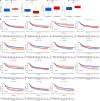Constructing and validating of m6a-related genes prognostic signature for stomach adenocarcinoma and immune infiltration: Potential biomarkers for predicting the overall survival
- PMID: 36620557
- PMCID: PMC9814967
- DOI: 10.3389/fonc.2022.1050288
Constructing and validating of m6a-related genes prognostic signature for stomach adenocarcinoma and immune infiltration: Potential biomarkers for predicting the overall survival
Abstract
Background: Stomach adenocarcinoma (STAD) arises from the mutations of stomach cells and has poor overall survival. Chemotherapy is commonly indicated for patients with stomach cancer following surgical resection. The most prevalent alteration that affects cancer growth is N6-methyladenosine methylation (m6A), although the possible function of m6A in STAD prognosis is not recognized.
Method: The research measured predictive FRGs in BLCA samples from the TCGA and GEO datasets. Data on the stemness indices (mRNAsi), gene mutations, copy number variations (CNV), tumor mutation burden (TMB), and corresponding clinical characteristics were obtained from TCGA and GEO. STAD from TCGA and GEO at 24 m6A was investigated. Lasso regression was used to construct the prediction model to assess the m6A prognostic signals in STAD. In addition, the correlation between m6a and immune infiltration in STAD patients was discussed using GSVA and ssGSEA analysis. Based on these genes, GO and KEGG analyses were performed to identify key biological functions and key pathways.
Result: A significant relationship was discovered between numerous m6A clusters and the tumor immune microenvironment, as well as three m6A alteration patterns with different clinical outcomes. Furthermore, GSVA and ssGSEA showed that m6A clusters were significantly associated with immune infiltration in the STAD. The low-m6Ascore group had a lower immunotherapeutic response than the high-m6Ascore group. ICIs therapy was more effective in the group with a higher m6Ascore. Three writers (VIRMA, ZC3H13, and METTL3) showed significantly lower expression, whereas five authors (METTL14, METTL16, WTAP, RBM15, and RBM15B) showed considerably higher expression. Three readers (YTHDC2, YTHDF2, and LRPPRC) had higher levels of expression, whereas eleven readers (YTHDC1, YTHDF1, YTHDF3, HNRNPC, FMR1, HNRNPA2B1, IGFBP1, IGFBP2, IGFBP3, and RBMX) had lower levels. As can be observed, the various types of m6 encoders have varied ramifications for STAD control.
Conclusion: STAD occurrence and progression are linked to m6A-genes. Corresponding prognostic models help forecast the prognosis of STAD patients. m6A-genes and associated immune cell infiltration in the tumor microenvironment (TME) may serve as potential therapeutic targets in STAD, which requires further trials. In addition, the m6a-related gene signature offers a viable alternative to predict bladder cancer, and these m6A-genes show a prospective research area for STAD targeted treatment in the future.
Keywords: CNV; M6A; SNP; immunity; predicting model; stomach adenocarcinoma (STAD).
Copyright © 2022 Yang, Wu, Wu, Chen, Xia and Zeng.
Conflict of interest statement
The authors declare that the research was conducted in the absence of any commercial or financial relationships that could be construed as a potential conflict of interest.
Figures









Similar articles
-
Comprehensive analysis of m6A related gene mutation characteristics and prognosis in colorectal cancer.BMC Med Genomics. 2023 May 16;16(1):105. doi: 10.1186/s12920-023-01509-8. BMC Med Genomics. 2023. PMID: 37194014 Free PMC article.
-
Glutamine metabolism genes prognostic signature for stomach adenocarcinoma and immune infiltration: potential biomarkers for predicting overall survival.Front Oncol. 2023 Jun 12;13:1201297. doi: 10.3389/fonc.2023.1201297. eCollection 2023. Front Oncol. 2023. PMID: 37377916 Free PMC article.
-
Characterizing m6A modification factors and their interactions in colorectal cancer: implications for tumor subtypes and clinical outcomes.Discov Oncol. 2024 Sep 18;15(1):457. doi: 10.1007/s12672-024-01298-1. Discov Oncol. 2024. PMID: 39292326 Free PMC article.
-
Identification and characterization of nucleotide metabolism and neuroendocrine regulation-associated modification patterns in stomach adenocarcinoma with auxiliary prognostic assessment and immunotherapy response prediction.Front Endocrinol (Lausanne). 2023 Jan 16;13:1076521. doi: 10.3389/fendo.2022.1076521. eCollection 2022. Front Endocrinol (Lausanne). 2023. PMID: 36726460 Free PMC article. Review.
-
Function and clinical significance of N6-methyladenosine in digestive system tumours.Exp Hematol Oncol. 2021 Jul 10;10(1):40. doi: 10.1186/s40164-021-00234-1. Exp Hematol Oncol. 2021. PMID: 34246319 Free PMC article. Review.
Cited by
-
PIWI-interacting RNA-17458 is oncogenic and a potential therapeutic target in cervical cancer.J Cancer. 2023 Jun 4;14(9):1648-1659. doi: 10.7150/jca.83446. eCollection 2023. J Cancer. 2023. PMID: 37325054 Free PMC article.
-
The role of RNA binding proteins in cancer biology: A focus on FMRP.Genes Dis. 2024 Dec 21;12(4):101493. doi: 10.1016/j.gendis.2024.101493. eCollection 2025 Jul. Genes Dis. 2024. PMID: 40271197 Free PMC article. Review.
-
Insulin-like growth factor binding protein 2: a core biomarker of left ventricular dysfunction in dilated cardiomyopathy.Hereditas. 2023 Oct 31;160(1):36. doi: 10.1186/s41065-023-00298-5. Hereditas. 2023. PMID: 37904201 Free PMC article.
-
Mechanisms and clinical landscape of N6-methyladenosine (m6A) RNA modification in gastrointestinal tract cancers.Mol Cell Biochem. 2024 Jul;479(7):1553-1570. doi: 10.1007/s11010-024-05040-x. Epub 2024 Jun 10. Mol Cell Biochem. 2024. PMID: 38856795 Free PMC article. Review.
-
Identification of memory B-cell-associated miRNA signature to establish a prognostic model in gastric adenocarcinoma.J Transl Med. 2023 Sep 21;21(1):648. doi: 10.1186/s12967-023-04366-2. J Transl Med. 2023. PMID: 37735667 Free PMC article.
References
LinkOut - more resources
Full Text Sources
Research Materials
Miscellaneous

